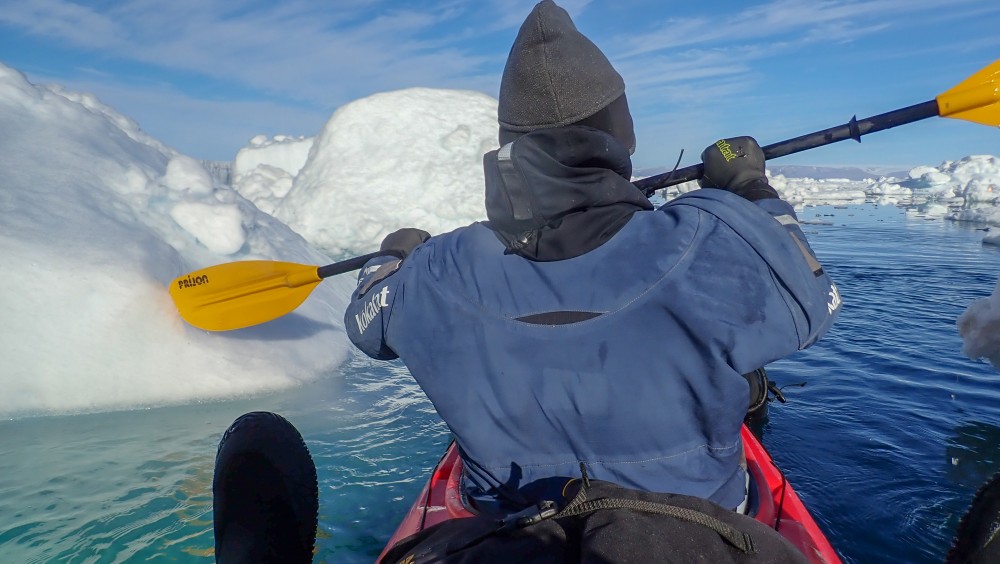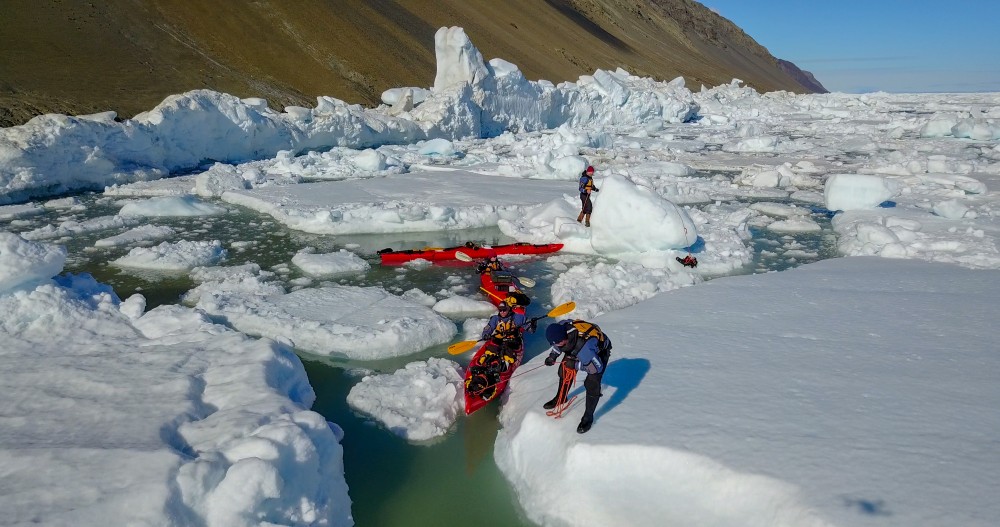"That was the best day. And that was day two," he says. "There were no good days after that."
Horvat is the subject Enduring Ice, a film about the trials and tribulations of studying sea ice in Nares Strait: the one place on Earth where climate models predict that ice lasts the longest. At first, the film's intent was to capture Horvat's research while he and a small team kayaked 500 kilometers down the length of the strait. But, as Horvat and filmmakers Stephen Smith and Diana Kushner found out, the story the climate models tell is simply wrong.
As the planet has warmed, even this ‘enduring' ice has failed to form.
"Before, you had these big chunks of ice that would glom up the channel," explains Horvat. "They would stop the ice, or keep it from going through from the Arctic."
"You could kayak in the lee of these big pieces of sea ice," he continues. "But now, because of melting, the ice fragments really easily and it just kind of pours through."
These crowded conditions made the strait impossible for Horvat and the rest of the team to navigate. Instead, they hauled thousand-pound kayaks on their backs through the Arctic tundra for 33 days—the length of time it took, over such rugged terrain, to arrive at the closest place they could build an airstrip.

"There's a tree line at about 65 degrees North. We were at 80 degrees North," says Horvat. "No trees, no nothing; it looks like Mars. And so the wind doesn't get stopped by anything."
Twice, the team was stuck in days-long storms.
"The winds were above 100 miles per hour and it was totally exposed," recalls Horvat. "It was terrifying. We had to all lie in the tent at the same time because it would blow away if we didn't."
This July, the team plans to return to Nares Strait. But this time, they will arrive and remain at the southerly end of the channel—where they had intended to end their trip last year.
Horvat will employ two research drones to gather measurements and take pictures of the fragmented sea ice, and then compute the so-called floe size distribution, or the assorted sizes of ice chunks floating in the strait.
His goal is to provide proof-of-concept of this type of work. Compared to the cost of riding an Arctic research vessel, his brand of observations run considerably cheaper. But they are both equally rigorous and equally important.

As he explains, in a field where it is often difficult to tease out signal from noise, melting sea ice is an obvious and threatening sign of a changing climate.
For instance, although the entire United States has been experiencing fewer days below freezing overall, most Americans are only able to recall recent, cold winters—winters that, taken alone and at face value, may suggest that global warming is an exaggeration.
"It is easy to be biased by recent events, but the reduction in sea ice is incontrovertible" says Horvat. "You can see it from a satellite. Literally, there's less of it now, and we can directly attribute that to warming."
This is why his research, and the film documenting it, is so vital.
Even ice that was thought to be hardy and safe has thinned and fragmented due to the outsized effects of climate change on the Arctic. And this fragmenting is taking place in a strait that is responsible for the fate of around 10% of the sea ice lost in the Arctic every year.
"When Nares Strait is closed, that sea ice stays; when it's open, that sea ice is exported," explains Horvat. "And it has been open for 10 years because the ice floes are smaller now."
"We went up and found that," he says. "And it wasn't on purpose, but people didn't know that. There was a reason that everyone thought this was where the ice would stay the longest—because every model says it would stay there the longest."
But it isn't true. As Horvat can attest, thin, broken sea ice is flowing right through Nares Strait and out of the Arctic. And the less sea ice that is present in the Arctic, the less sunlight is reflected back to space, and the more warming is confined to Earth.
"My research says we need to start taking account of these floes," says Horvat. "They are the thing that shapes how the sea ice will evolve. And how the sea ice goes is how climate goes in the lower latitudes."
There may no longer be any enduring ice. Horvat wants to find out what the consequences of this are for the wider planet.
More information about Horvat and the film Enduring Ice can be found on the film's website.